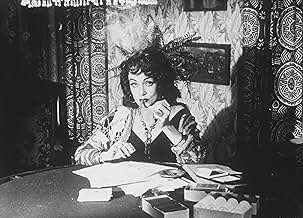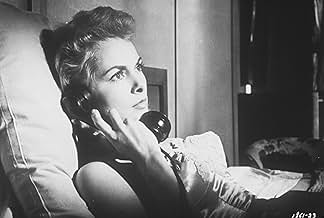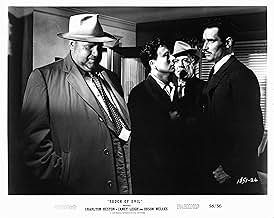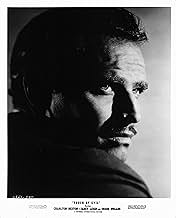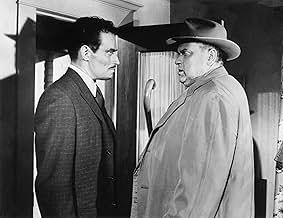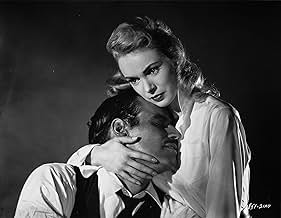मैक्सिकन सीमावर्ती शहर में हत्या, अपहरण और पुलिस भ्रष्टाचार की एक कठोर, विकृत कहानी।मैक्सिकन सीमावर्ती शहर में हत्या, अपहरण और पुलिस भ्रष्टाचार की एक कठोर, विकृत कहानी।मैक्सिकन सीमावर्ती शहर में हत्या, अपहरण और पुलिस भ्रष्टाचार की एक कठोर, विकृत कहानी।
- पुरस्कार
- 7 जीत और कुल 1 नामांकन
Valentin de Vargas
- Pancho
- (as Valentin De Vargas)
फ़ीचर्ड समीक्षाएं
That's a great epitaph Marlene Dietrich and Mort Mills put together for Orson Welles's character police captain Hank Quinlan. In a sense, since Welles directed himself in Touch of Evil he both created the character and the circumstances that bring him down.
Two stories intersect in Touch of Evil. The first involves a particularly grisly murder in a Texas/Mexican border town of a man named Rudy Linnaker. The weapon was a car bomb, that went off just as Linnkaer and some chippie he was seeing crossed the border. Driving in the car just behind the late Mr. Linnaker was Charlton Heston as Mexican police detective Mike Vargas and his wife Janet Leigh.
Heston is returning to Mexico City where in a few days he's taking the witness stand in the trial of a local drug kingpin. The kingpin's brother is Akim Tamiroff who's the local crime lord in that border town. Heston's case against Tamiroff's brother and Welles's investigation into the car bombing are completely unrelated, but do to some cleverly worked out plot machinations they get intertwined together.
Charlton Heston has been quoted many times in saying that Orson Welles was the greatest director he ever worked for. He also rather modestly has stated that he did not give Welles his best screen performance. My own thought on it is that he really is not a terribly convincing latino. Maybe someone with Robert Mitchum's gift for dialect or a latino actor like Gilbert Roland might have been better. Still it's an earnest effort and Heston has nothing to be ashamed of.
In fact Heston says and I agree that the story is really about Welles and his destruction. Welles has great instinct as a detective, but he's not really all that scrupulous about due process. That's what has Heston's back up and it forces Welles into an unthinkable alliance with Tamiroff.
Janet Leigh gives us a sneak preview of what was in store for moviegoers in Psycho when she's trapped in that motel room with those punks that Tamiroff has sicced on her. One of the punks in fact was Mercedes McCambridge doing a little gender bending generations before Boys Don't Cry. At the motel Dennis Weaver has a marvelous bit part as the useless and feckless 'night man.'
Welles put a lot of his favorites in small roles here. Ray Collins took time away from Perry Mason on television to play the District Attorney. Joseph Cotten has a small bit as a medical examiner, Harry Shannon was the state's attorney, it was a regular Citizen Kane reunion.
Marlene Dietrich who was Welles's foil and partner in his magic act plays the owner of a border town dive and his mistress who loves him though she recognizes all his faults. This was a banner year for Dietrich because she also did her highly acclaimed role in Witness for the Prosecution.
One part though that should have been up for an Academy Award was Joseph Calleia who was Welles's devoted subordinate who in the end ironically helps to bring him down. It's a great piece of acting and Charlton Heston said that Joseph Calleia never did anything better in his entire cinema career. I wouldn't argue the point.
Now that the 'director's cut' is available we can now see Touch of Evil and realize what Welles's vision was for this film. Indifferently received when first out, it's grown to become a classic and probably one of the three or four films Welles the director gets the most acclaim for.
And now it's probably better than when first seen by the public.
Two stories intersect in Touch of Evil. The first involves a particularly grisly murder in a Texas/Mexican border town of a man named Rudy Linnaker. The weapon was a car bomb, that went off just as Linnkaer and some chippie he was seeing crossed the border. Driving in the car just behind the late Mr. Linnaker was Charlton Heston as Mexican police detective Mike Vargas and his wife Janet Leigh.
Heston is returning to Mexico City where in a few days he's taking the witness stand in the trial of a local drug kingpin. The kingpin's brother is Akim Tamiroff who's the local crime lord in that border town. Heston's case against Tamiroff's brother and Welles's investigation into the car bombing are completely unrelated, but do to some cleverly worked out plot machinations they get intertwined together.
Charlton Heston has been quoted many times in saying that Orson Welles was the greatest director he ever worked for. He also rather modestly has stated that he did not give Welles his best screen performance. My own thought on it is that he really is not a terribly convincing latino. Maybe someone with Robert Mitchum's gift for dialect or a latino actor like Gilbert Roland might have been better. Still it's an earnest effort and Heston has nothing to be ashamed of.
In fact Heston says and I agree that the story is really about Welles and his destruction. Welles has great instinct as a detective, but he's not really all that scrupulous about due process. That's what has Heston's back up and it forces Welles into an unthinkable alliance with Tamiroff.
Janet Leigh gives us a sneak preview of what was in store for moviegoers in Psycho when she's trapped in that motel room with those punks that Tamiroff has sicced on her. One of the punks in fact was Mercedes McCambridge doing a little gender bending generations before Boys Don't Cry. At the motel Dennis Weaver has a marvelous bit part as the useless and feckless 'night man.'
Welles put a lot of his favorites in small roles here. Ray Collins took time away from Perry Mason on television to play the District Attorney. Joseph Cotten has a small bit as a medical examiner, Harry Shannon was the state's attorney, it was a regular Citizen Kane reunion.
Marlene Dietrich who was Welles's foil and partner in his magic act plays the owner of a border town dive and his mistress who loves him though she recognizes all his faults. This was a banner year for Dietrich because she also did her highly acclaimed role in Witness for the Prosecution.
One part though that should have been up for an Academy Award was Joseph Calleia who was Welles's devoted subordinate who in the end ironically helps to bring him down. It's a great piece of acting and Charlton Heston said that Joseph Calleia never did anything better in his entire cinema career. I wouldn't argue the point.
Now that the 'director's cut' is available we can now see Touch of Evil and realize what Welles's vision was for this film. Indifferently received when first out, it's grown to become a classic and probably one of the three or four films Welles the director gets the most acclaim for.
And now it's probably better than when first seen by the public.
Here is a film that wouldn't be made today because nobody makes 'B' movies anymore; and this is the greatest 'B' movie in the history of cinema. Here is the perfect example of why Orson Welles should be considered a genius. He has made this film look so effortlessly easy that it could almost be considered film making by numbers. From the famous opening sequence to the closing titles, this is the film students' reference book.
Welles portrayal of the bloated cop Hank Quinlan is only bettered by his Harry Lime in 'The Third Man'. He gets right inside the seedy, corrupt Quinlan; but still leaves room for just the lightest touch sympathy because we know that, after all, he's a fallible human like all of us. We almost feel sad at his fate especially when Marlene Dietrich gives her sad soliliquay about him.
This is another film that can only exist in black and white, and begs the question, why can't directors work effectively in this medium today? Some have tried but none have have really suceeded. David Lynch's Eraserhead is probably the best modern example of a black and white only film. Woody Allen's Manhattan tries hard but ends up looking too much like a documentary. I don't think that directors today use this medium enough, too many rely on colour and the efffects that can only work in colour to get them out of trouble.
So put A Touch Of Evil on your 'must see' list and enjoy a work of film making artistry.
Welles portrayal of the bloated cop Hank Quinlan is only bettered by his Harry Lime in 'The Third Man'. He gets right inside the seedy, corrupt Quinlan; but still leaves room for just the lightest touch sympathy because we know that, after all, he's a fallible human like all of us. We almost feel sad at his fate especially when Marlene Dietrich gives her sad soliliquay about him.
This is another film that can only exist in black and white, and begs the question, why can't directors work effectively in this medium today? Some have tried but none have have really suceeded. David Lynch's Eraserhead is probably the best modern example of a black and white only film. Woody Allen's Manhattan tries hard but ends up looking too much like a documentary. I don't think that directors today use this medium enough, too many rely on colour and the efffects that can only work in colour to get them out of trouble.
So put A Touch Of Evil on your 'must see' list and enjoy a work of film making artistry.
Touch of Evil has, perhaps, the BEST cinematography and lighting in ANY film ever made. Not just in the film noir genre, but in all categories. Orson Welles tended to use wide shots for all of his films, and Touch of Evil's use of wide shots took filmmaking to another level, especially with the amazing opening shot. The camera techniques and lighting are too spectacular to fathom, it is the grandmaster of all movies. Brilliant is an understatement. See this film, if not for the excellent acting and sheer brilliance in terms of the camera (this film had a GREAT D.P.!!), but for entertainment value. But if you are a film student or just want to see great camera work, Touch of Evil will astonish you.
10Dr.Teeth
There are only two ways to write a review that would truly do this film justice. Either one would have to write an exceedingly long review, or a short, concise one. I choose to do the latter.
When I first saw "Touch of Evil," I was glued to the chair. When I found out it was not Welles' definitive vision, I wondered how on earth it could have been made better. And when I saw the re-released version, I wondered why the studio altered it. The stunning black-and-white images, the intricate plot, and the powerful, engaging performances took a hold of my imagination. At times, I imagined myself on the street with the characters, because the atmosphere was so thick I felt surrounded in it.
The actors all did an outstanding job, especially Leigh and Heston (who, although not thoroughly convincing as a Mexican, soared above his usual powerful, furious presence). This is Welles' picture, however, and whenever the camera catches his obese figure, you are fully aware of the man as a director and an actor. His powerful vision drives the film, from the single-cut opening sequence to the cat-and-mouse finale.
I suggest watching the 1998 restored version over the original theatrical release, but regardless of which version, "Touch of Evil" will have you stuck in your seat, questioning your views of morality until long after the last credit has rolled up the screen.
When I first saw "Touch of Evil," I was glued to the chair. When I found out it was not Welles' definitive vision, I wondered how on earth it could have been made better. And when I saw the re-released version, I wondered why the studio altered it. The stunning black-and-white images, the intricate plot, and the powerful, engaging performances took a hold of my imagination. At times, I imagined myself on the street with the characters, because the atmosphere was so thick I felt surrounded in it.
The actors all did an outstanding job, especially Leigh and Heston (who, although not thoroughly convincing as a Mexican, soared above his usual powerful, furious presence). This is Welles' picture, however, and whenever the camera catches his obese figure, you are fully aware of the man as a director and an actor. His powerful vision drives the film, from the single-cut opening sequence to the cat-and-mouse finale.
I suggest watching the 1998 restored version over the original theatrical release, but regardless of which version, "Touch of Evil" will have you stuck in your seat, questioning your views of morality until long after the last credit has rolled up the screen.
Considered by many to be the last "classic" noir film ever made, and perhaps the last masterwork from child prodigy Orson Welles, who looks about sixty in this film, despite his 42 years. In TOUCH OF EVIL the "noirish" dark streets and shadows are darker than ever, practically swallowing up the soft tones like a murky swamp. The action takes place in a nondescript U.S./Mexico border town where the worst that both sides has to offer is most in evidence. The famous opening scene (a 3 1/2-minute continuous shot) where we witness a time bomb being placed in the trunk of a Cadillac is masterful. The camera pulls in and out of the city scene as it follows the motion of the vehicle winding its way through streets littered with pedestrians, thus effectively creating a level of anxiety that could not be duplicated with multiple edits. After the inevitable explosion, the drama dives into a seedy world of corrupt police justice and malevolent decrepitude, which is filmed with such a stylish flair, it is almost weirdly humorous and playful! Mike Vargas, the good guy, is played by Charlton Heston and seems more than a wee bit miscast as a Mexican narcotics officer with his face darkened by makeup. When U.S. Police Captain Hank Quinlan (Orson Welles) first meets him he remarks, "He doesn't look Mexican." Quinlan is the ultimate repugnant cop gone bad and Welles has the camera looking up into his nostrils most of the time making his character look even more monstrous. But Quinlan is also pitifully sad. A man who once had the instincts of a cat and the intelligence of a fox has been reduced to an insignificant mass of tissue, who's "instinct" is having a knack for finding evidence that he himself has planted. And while he may be revered by the local officials in law enforcement, he's acutely aware that he is a fraud and petrified that Vargas, has seen him naked.
क्या आपको पता है
- ट्रिवियाJanet Leigh's agent initially rejected her participation in this film due to the low salary offered without even consulting the actress. Orson Welles, anticipating this, sent a personal letter to the actress, telling her how much he looked forward to their working together. Leigh, furious, confronted her agent telling him that getting directed by Welles was more important than any paycheck.
- गूफ़The car that blows up four minutes into the film has the Texas plate AG 3724; 32 minutes into the film, police car number 10 also has the Texas plate AG 3724.
- क्रेज़ी क्रेडिटOpening statement (restored version): In 1957, Orson Welles completed principal photography on TOUCH OF EVIL and edited the first cut. Upon screening the film, the Studio felt it could be improved, shot additional scenes and re-edited it. Welles viewed this new version and within hours wrote a passionate 58-page memo requesting editorial changes. This version represents an attempt to honor those requests and make TOUCH OF EVIL the film Orson Welles envisioned it to be. "... I close this memo with a very earnest plea that you consent to this brief visual pattern to which I gave so many long hard days of work." -- Orson Welles
- इसके अलावा अन्य वर्जनA new version, running 111 minutes, has been restored by Universal and debuted at the Telluride Film Festival in September 1998. This version has been re-edited according to Orson Welles' original vision, as outlined in a 58-page memo that the director wrote to Universal studio head Edward Muhl in 1957, after Muhl took editing out of Welles' hands. The new version has been prepared by editor by Walter Murch, sound recordists Bill Varney, Peter Reale and Murch, and picture restorer Bob O'Neil under the supervision of Rick Schmidlin and film critic Jonathan Rosenbaum. One difference between the two versions is that the famous opening tracking shot is now devoid of credits and Henry Mancini's music, featuring only sound effects.
- कनेक्शनEdited into American Cinema: Film Noir (1995)
- साउंडट्रैकMain Title (Touch of Evil)
Written by Henry Mancini
Performed by United International Orchestra;
Rolly Bundock (bass); Shelly Manne (drums); Barney Kessel (guitar); Jack Costanzo, Mike Pacheco (percussion); Ray Sherman (piano); Dave Pell (baritone sax); Plas Johnson (tenor sax)Conrad Gozzo, Pete Candoli, Ray Linn (trumpets) ;Red Norvo (vibes)
टॉप पसंद
रेटिंग देने के लिए साइन-इन करें और वैयक्तिकृत सुझावों के लिए वॉचलिस्ट करें
विवरण
- रिलीज़ की तारीख़
- कंट्री ऑफ़ ओरिजिन
- भाषाएं
- इस रूप में भी जाना जाता है
- Sed de mal
- फ़िल्माने की जगहें
- El Rancho Courson Motel, SW corner of E Barrel Springs Rd and Courson Ranch Road, Palmdale, कैलिफोर्निया, संयुक्त राज्य अमेरिका(Mirador Motel - now site of a residential cul-de-sac)
- उत्पादन कंपनी
- IMDbPro पर और कंपनी क्रेडिट देखें
बॉक्स ऑफ़िस
- बजट
- $8,29,000(अनुमानित)
- US और कनाडा में सकल
- $22,47,465
- US और कनाडा में पहले सप्ताह में कुल कमाई
- $70,725
- 13 सित॰ 1998
- दुनिया भर में सकल
- $22,85,063
- चलने की अवधि
- 1 घं 35 मि(95 min)
- रंग
इस पेज में योगदान दें
किसी बदलाव का सुझाव दें या अनुपलब्ध कॉन्टेंट जोड़ें



